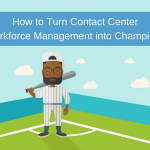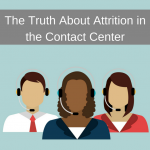What Your Workforce Management Team Wishes HR Knew

Whether you’re running your own in-house call center or working closely with an outsourced contact center to manage the load, chances are your workforce management team and your HR teams have had the occasional struggle to understand one another.
As the senior vice president of corporate services at Blue Ocean, both our workforce team and our HR team report up to me. I know that the gap of understanding can be very wide between these two crucial teams with their specialized areas of expertise. In our world, success for those two teams is often measured in competing metrics and outcomes, but for success to be achieved on both sides, they must be on the same page.
Here’s a quick take on bridging the divide between the worlds of Workforce Management and HR, from the WFM point of view. (In a future blog, we’ll consider this same topic from the HR perspective!)
1. Standard Shifts Makes WFM’s Jobs Harder
HR’s job is to create an engaging employment experience, and one of the most elemental concepts to a universal engaging experience is consistency. Often for employees, consistent schedules and set shifts are preferable. However, limiting scheduling flexibility is most likely not the most efficient strategy for the workforce management team.
Unlike other departments within a company, the contact center is driven by fluctuating volume by the day, time of day, day of week, and season, which can have a significant effect on workforce needs. To most effectively meet this fluctuating volume, strategies like staggered shift starts, split shifts, and part-time employees are highly valuable.
2. WFM Is Measured on Efficiency
While success in the HR world is often measured on metrics like hiring stats, retention, attrition, and engagement, WFM must deliver on metrics of efficiency and productivity while meeting grade of service goals as closely as possible – all while aiming for exceptional customer experience and high CSAT scores.
Under those parameters, WFM is highly focused on achieving the most efficient deployment of human resources – it’s not surprising that this often bumps up against HR’s objectives. Obviously both teams are critical to the project, so common ground must be sought out in order to maximize efficiency and effectiveness.
3. Productivity Should Be a Common Goal
In finding that common ground, both teams need to have common goals. Productivity is one place where there is common ground to be found. While establishing a great employment experience is important, being work-ready is the first priority. When HR and WFM have a good working relationship, productivity should be a natural by-product. When people are engaged in their workplace, they want to be ready and available for work.
A steady pace of work can contribute to positive employee engagement. In employee focus groups, we’ve heard agents prefer a steady flow of work. Overwhelming volume adds to stress. And low volume/overstaffing contributes to boredom/disengagement. By balancing the pace of work to the degree that is possible through forecasting, scheduling, staffing, real time analysis, and skill assignments, your workforce team directly impacts the agent experience.
When everyone on the team is managing their time and availability in a way that contributes to team outcomes, it’s only then that you have a true picture of WFM’s ability to meet volume. Plus, when total productivity is achieved, this of course reduces pressure on HR to recruit. It’s a win-win situation.
Got more questions about how Workforce Management and HR can work together? Contact us today to learn more.



